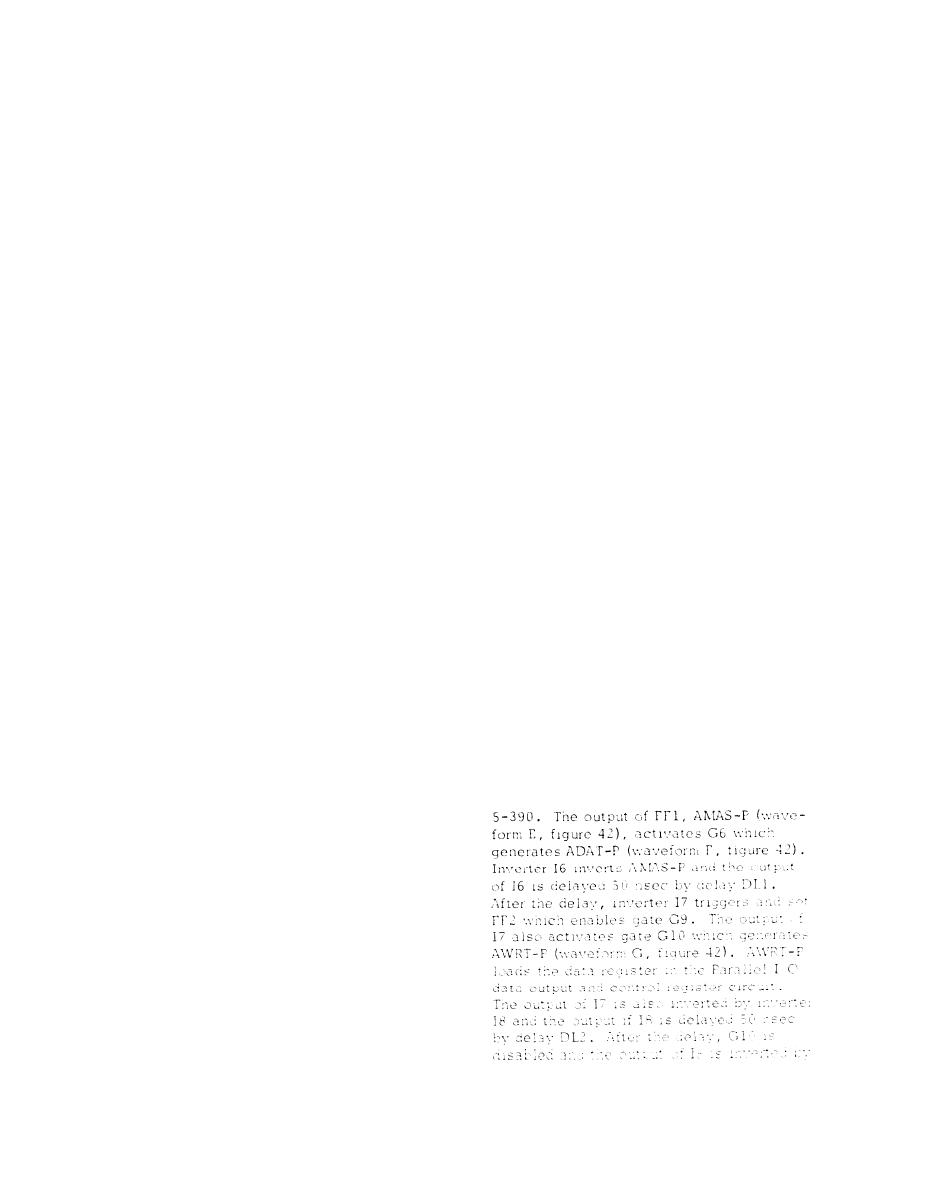 |
|||
|
|
|||
|
Page Title:
PARALLEL I/O AlA3A10 ADDRESS RECEIVERS AND RECOGNITION CIRCUIT-CONT. |
|
||
| ||||||||||
|
|
 T.O. 31S5-4-308-1
TM 11-5805-663-14-13
NAVELEX 0967-464-0010
5 - 3 8 6 . Detail Analysis (see figure 41).
Gate G3 will be disabled if the correct
The device number connector J3 connec-
combination of A01A-P, A02A-P and
tions determine the Parallel I/O address
A03A-P are received to select one of
(device number). DN04-N through DN11-N,
the Parallel I/O internal registers.
device number bits, are routed to the
Parallel I/O data input and selector cir-
cuit to be placed on the INFIBUS data
5 - 3 8 9 . To perform a write operation to
lines when the Parallel I/O is requesting
the Parallel I/O data register, the master
a level 1 INFIBUS access. The device
function generates the address (waveform
number inverters (14 shown) generate
A, figure 42), data, and strobe on the
DA04-P through DA11-P. AB0l-N through
INFIBUS and generates RITE-N (waveform
AB15-N from the INFIBUS address lines
B, figure 42). The address will be recog-
are inverted by the address bus receivers
nized which enables FFl to be set, as
U10, U20, U29, and U40 (11 shown) which
explained previously. G3 generates
generate A01A-P through Al5A-P.
AABL-P (waveform C, f i g u r e 4 2 ) a n d e n a b l e s
the set input of flip-flop FF2. RITE-N is
inverted by inverter I11 which enables
5-387. A04A-P through A11A-P are applied
to the address recognition exclusive-nor
G7 and G10. The output of I11 is also
gates U19, U28, and U33 (Gl shown)
inverted by inverter I12 which disables
gate G11 causing ARED-P to go low. If the
where they are compared with the lumper
Alarm Control and VF Comm Link is ready to
encoded device number (DA04-P through
a c c e p t d a t a , WBAR-N is low which disables
D A l l - P ) . If there is a match at the inputs,
g a t e G 7 . The high output of G7 enables
the corresponding outputs of address re-
gate G8. The parallel I/O INFIBUS access
cognition exclusive-nor gates U19, U28,
circuit generates STRA-P (waveform D, fig-
and U39 will be high. Also, for address
ure 42) which is applied to driver DR2. The
recognition, A12A-P must be high which is
output of DR2 is coupled through driver DR3
coupled through driver DRl. In addition,
then delayed 50 nsee by delay DL4. The
A13A-P, A14A-P and A15A-P must be high
output of DL4 activates gate G8 which
which activates gate G2. The combined
triggers and sets FF1. If the Alarm Con-
outputs of address recognition exclusive-
trol and VF Comm Link function is not
nor gates U19, U28, and U39, driver DRl,
ready to accept data, WBAR-N from the
and G2 will be high which places a high
read-write control status circuit is high
at the set input of flip-flop FF1.
w h i c h a c t i v a t e s G 7 . The output of G7
now disables G8 until the Alarm Control
5-388. Inverters I2, I3, and I5, and
and VF Comm Link Function is ready
gates G3 through G6 decode A01A-P,
When ready, WBAR-N returns to low dis-
A02A-P, and A03A-P to select the control,
abling G7 which activates G8.
status, or data registers in the Parallel
I/O data output and control register cir-
cuit. To select the control register, A01A-P
and A02A-P are high and A03A-P is low.
Gate G4 is enabled by A0lA-P and AO2A-P
and the high output of I5. G4 is act!-
vated and generates ACNT-N when FF1
i s s e t . To select the status register,
A0lA-P, A02A-P and A03A-F are all low
and the high outputs of I2, I3, and I5
enable G5. When FFl set;, G5 is acti-
vated which genetates AWST-N . To
select the data register, A01A-P and
A02A-P are low and A03A-P is high. G6
is enabled by the outputs of I2 and I3
and A03A-P. When FF1 is set, G6 will
be
activated
which
generates
ADAT-P.
5-56
|
|
Privacy Statement - Press Release - Copyright Information. - Contact Us |